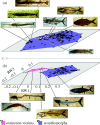Explosive morphological diversification of spiny-finned teleost fishes in the aftermath of the end-Cretaceous extinction
- PMID: 20133356
- PMCID: PMC2871855
- DOI: 10.1098/rspb.2009.2177
Explosive morphological diversification of spiny-finned teleost fishes in the aftermath of the end-Cretaceous extinction
Abstract
The spiny-finned teleost fishes (Acanthomorpha) include nearly one-third of all living vertebrate species and assume a bewildering array of bodyplans, but the macroevolutionary assembly of modern acanthomorph biodiversity remains largely unexplored. Here, I reconstruct the trajectory of morphological diversification in this major radiation from its first appearance in the Late Cretaceous to the Miocene using a geometric morphometric database comprising more than 600 extinct species known from complete body fossils. The anatomical diversity (disparity) of acanthomorphs is low throughout the Cretaceous, increases sharply and significantly in the wake of the Cretaceous-Palaeogene (K-P) extinction, and shows little change throughout subsequent Cenozoic intervals. This pattern of morphological diversification appears robust to two potential biasing factors: the 'Lagerstätten effect', and the non-random segregation of rare and common taxa along phenotypic axes. Dissecting the trajectory of acanthomorph radiation along phylogenetic lines reveals that the abrupt post-extinction increase in disparity is driven largely by the proliferation of trophically diverse modern groups within Percomorpha, a spiny-fin subclade containing more than 15 000 living species and identified as showing a substantially elevated diversification rate relative to background vertebrate levels. A major component of the Palaeogene acanthomorph radiation reflects colonization of morphospace previously occupied by non-acanthomorph victims of the K-P. However, other aspects of morphological diversification cannot be explained by this simple ecological release model, suggesting that multiple factors contributed to the prolific anatomical radiation of acanthomorphs.
Figures



Similar articles
-
Prolonged morphological expansion of spiny-rayed fishes following the end-Cretaceous.Nat Ecol Evol. 2022 Aug;6(8):1211-1220. doi: 10.1038/s41559-022-01801-3. Epub 2022 Jul 14. Nat Ecol Evol. 2022. PMID: 35835827
-
Exceptional preservation of a Cretaceous intestine provides a glimpse of the early ecological diversity of spiny-rayed fishes (Acanthomorpha, Teleostei).Sci Rep. 2018 May 31;8(1):8509. doi: 10.1038/s41598-018-26744-3. Sci Rep. 2018. PMID: 29855529 Free PMC article.
-
Explosive diversification of marine fishes at the Cretaceous-Palaeogene boundary.Nat Ecol Evol. 2018 Apr;2(4):688-696. doi: 10.1038/s41559-018-0494-6. Epub 2018 Mar 12. Nat Ecol Evol. 2018. PMID: 29531346
-
Permian-Triassic Osteichthyes (bony fishes): diversity dynamics and body size evolution.Biol Rev Camb Philos Soc. 2016 Feb;91(1):106-47. doi: 10.1111/brv.12161. Epub 2014 Nov 27. Biol Rev Camb Philos Soc. 2016. PMID: 25431138 Review.
-
'Fish' (Actinopterygii and Elasmobranchii) diversification patterns through deep time.Biol Rev Camb Philos Soc. 2016 Nov;91(4):950-981. doi: 10.1111/brv.12203. Epub 2015 Jun 23. Biol Rev Camb Philos Soc. 2016. PMID: 26105527 Review.
Cited by
-
Clades reach highest morphological disparity early in their evolution.Proc Natl Acad Sci U S A. 2013 Aug 20;110(34):13875-9. doi: 10.1073/pnas.1302642110. Epub 2013 Jul 24. Proc Natl Acad Sci U S A. 2013. PMID: 23884651 Free PMC article.
-
Extreme Morphology, Functional Trade-offs, and Evolutionary Dynamics in a Clade of Open-Ocean Fishes (Perciformes: Bramidae).Integr Org Biol. 2021 Feb 16;3(1):obab003. doi: 10.1093/iob/obab003. eCollection 2021. Integr Org Biol. 2021. PMID: 33937628 Free PMC article.
-
A fossil assemblage from the mid-late Maastrichtian of Gavdos Island, Greece, provides insights into the pre-extinction pelagic ichthyofaunas of the Tethys.PLoS One. 2022 Apr 13;17(4):e0265780. doi: 10.1371/journal.pone.0265780. eCollection 2022. PLoS One. 2022. PMID: 35417474 Free PMC article.
-
Giant gar from directly above the Cretaceous-Palaeogene boundary suggests healthy freshwater ecosystems existed within thousands of years of the asteroid impact.Biol Lett. 2022 Jun;18(6):20220118. doi: 10.1098/rsbl.2022.0118. Epub 2022 Jun 15. Biol Lett. 2022. PMID: 35702983 Free PMC article.
-
Morphological Diversity and Evolution of Jaw Morphologies in Zeiform Fishes (Teleostei, Paracanthopterygii).Integr Org Biol. 2024 Apr 15;6(1):obae011. doi: 10.1093/iob/obae011. eCollection 2024. Integr Org Biol. 2024. PMID: 38741668 Free PMC article.
References
-
- Adams D. C., Berns C. M., Kozak K. H., Wiens J. J.2009Are rates of species diversification correlated with rates of morphological evolution? Proc. R. Soc. B 276, 2729–2738 (doi:10.1098/rspb.2009.0543) - DOI - PMC - PubMed
-
- Alfaro M. E., Santini F., Brock C. D.2007Do reefs drive diversification in marine teleosts? Evidence from the pufferfishes and their allies (Order Tetraodontiformes). Evolution 61, 2104–2126 (doi:10.1111/j.1558-5646.2007.00182.x) - DOI - PubMed
-
- Alfaro M. E., Brock C. D., Banbury B. L., Wainwright P. C.2009aDoes evolutionary innovation in pharyngeal jaws lead to rapid lineage diversification in labrid fishes? BMC Evol. Biol. 9, 255 (doi:10.1186/1471-2148-9-255) - DOI - PMC - PubMed
-
- Alfaro M. E., Santini F., Brock C., Alamillo H., Dorburg A., Rabosky D. L., Carnevale G., Harmon L. J.2009bNine exceptional radiations plus high turnover explain species diversity in jawed vertebrates. Proc. Natl Acad. Sci. USA 106, 13 410–13 414 (doi:10.1073/pnas.0811087106) - DOI - PMC - PubMed
-
- Alroy J. A.1999The fossil record of North American mammals: evidence for a Paleocene evolutionary radiation. Syst. Biol. 48, 107–118 (doi:10.1080/106351599260472) - DOI - PubMed
Publication types
MeSH terms
LinkOut - more resources
Full Text Sources

